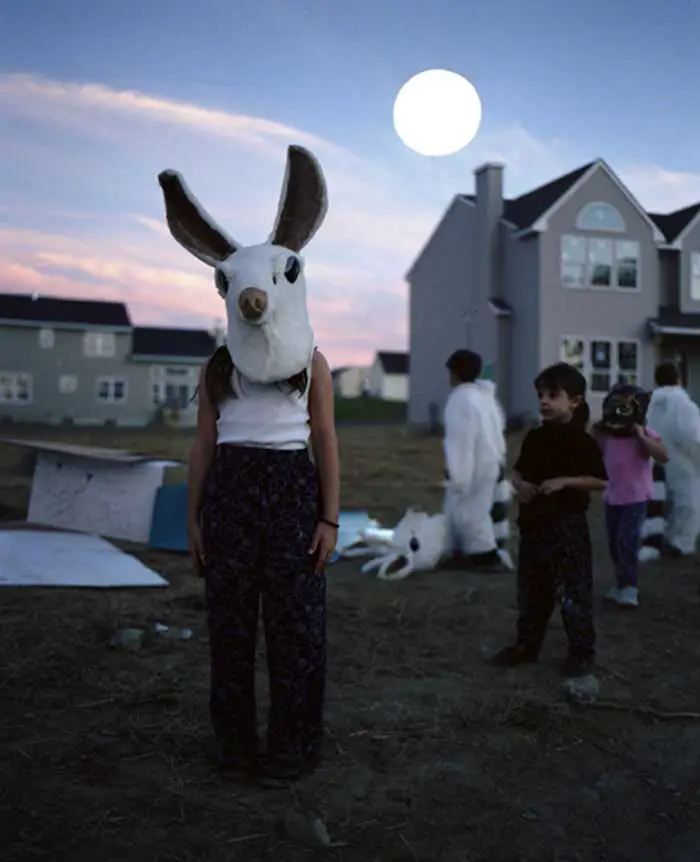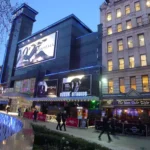Architecture on Film London, Building, Barbican Cinema News, Tickets, Venue, Phone, Development
Architecture on Film : Suburban Dreams
Cinema Event at The Barbican, London, England, UK
30 Apr 2009
Architecture Film London
The Architecture Foundation’s next Architecture on Film screening
The event is called Suburban Dreams and takes place on 18 May, and takes a look at the myth and cult of the America Suburb with Pierre Huygue’s short Streamside Day (last seen at his Tate show a few years back):
Pierre Huyghe
Streamside Day, 2003
Streamside Day is an annual celebration
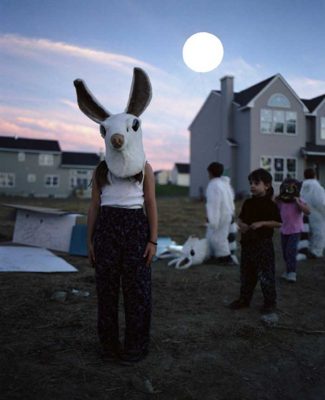
Event, mixed media, film and video transfers, 26 min, colour, sound
Courtesy of the artist and Marian Goodman Gallery, New York/ Paris
Excerpt + interview : www.pbs.org/art21/artists/huyghe/clip2l
This will be followed by the UK premiere of John O’Hagan’s Wonderland which takes a look at Levittown- America’s first planned suburb:
There’s lots about Levittown here:
https://en.wikipedia.org/wiki/Levittown,_New_York
Short film review : www.filmcritic.com/misc/emporium.nsf/reviews/Wonderland-(1997)
Text (below) by Geoff Shearcroft of architects AOC who will be introducing the films on the night:
Suburban Dreams
John O’Hagan’s film ‘Wonderland’ provides a tender and brutal dissection of the suburban dream. Filmed in Levittown, New York, on its 50th anniversary, Hagan presents a motley crew of residents pursuing their own visions of happiness in the first mass-produced suburbia.
The karaoke regular who strives to be a successful soul singer; the local girl that becomes a state beauty queen; the widower chasing the elusive 300 point ten-pin game; the couple who long to live in a ‘real wood’ world. Varied as they appear, the dreams of the Levittown residents rarely extend beyond the options immediately available. Hence the apparent popularity of wife swapping, a suburban alternative to the more urbane affair.
The evolution of the Levittown homes suggests a similar pragmatism, constrained by the limited tools available. Last December I got to see this for myself when we took our students to Levittown, Philadelphia, the second suburb constructed by the Levitt brothers. Originally only six basic models, no two houses now look the same. The single storey, detached timber frame buildings have been extended, refurbished, adapted and topped off with seasonal neon, inflatables and fake snow. Each home is a billboard declaring it’s resident’s needs and aspirations.
The main shop in Levittown is the Home Depot superstore, a metal shed on the edge of town that replaced the original Shop-A-Rama. Here the shelves were lined with the materials and decorations that we’d seen creating the ‘individual’ homes. Revisiting our photographs it became apparent that the adaptations, what we perceived as the self-expression of the residents, were severely limited to Home Depot’s stock of weatherboarding, inflatable reindeers, spray on snow, and ‘JOY’ sculptures. Less supply and demand, more supply and accept.
In 1948 William Levitt declared, “No one who owns his own house and lot can be a Communist. He has too much to do.” This raises many questions about Levitt and his own politics but its real interest relates to Levittown and the volume built, detached home suburban model that is so popular throughout the world today. A Marxist reading of this quote is that DIY, gardening and general home improvement might just be the opiate of the masses.
The satisfaction of owning your ‘lot’ – the downsized, but democratic, castle of the mythical Englishman – reduces any concern for the greater good. The time and resources required to operate, maintain and improve both the myth and the reality of the home is such that every other political aspiration falls by the wayside. As Ron Rosenbaum stated in Esquire in 1983, “We can look at the Levittown experience as an exact metaphor for the theory of American individualism. Those identical blank-faced Cape Cod pods all created equal, read to be inhabited, invigorated, individuated by democratic, undictated-to expressions of free will.”
Another reading of Levitt’s declaration is to consider the implications of being called a Communist in America in 1948. Two years before the rise of Levitt’s commie-outing friend Senator McCarthy, to be a Communist was to be an outsider. Like being homosexual. Or black. Levittown was white-only for the first ten years and remains 94% white today.
It firmly established the suburban stereotype of a sprawling ghetto for white middle class families, in which the identical houses represented the identical residents. Although this view is still common today it is a crude observation and frequently wrong on both accounts. In contemporary Levittown the variety of the houses belies the relative homogeneity of the residents, when compared with nearby New York. By contrast, the near-identical semis of London’s inter-war suburbs host an ethically diverse and socially mobile population.
Acknowledging that suburbs can be as different from one another as cities starts to help understand the potential diversity and attraction of the suburban home and its associated aspirations. The UK today is 86% suburban, a figure that embraces the full range of suburban forms, from scattered estates in rural land to 20th century peripheral sprawl. As with Levittown’s first residents the majority of these suburbanites want an affordable home in the right location with a bit of land they can call their own. Repeated research and national polls suggest the majority of people believe this dream is best met by the detached house.
Policymakers, politicians, planners, environmentalists and architects of the last decade appear to share an undeniable truth that the detached suburban home is environmentally unsustainable, a view reinforced by the recent output of the volume housebuilders. In 1993 architects Brenda and Robert Vale built the UK’s first autonomous family house on a suburban site in Nottinghamshire.
Looking remarkably ordinary and costing only 10% more than a regular home of similar size it produces its own energy, harvests its own water and processes its own waste. Just one example of many successful suburban living experiments, its lack of implementation highlights the lack of information dissemination and development of sustainable suburban models. Like Levittown’s Home Depot customers it would seem the establishment controlling the future form of our homes are limited in their dreams to a constrained set of familiar options.
The majority of the Wonderland protagonists demonstrate a remarkable keenness to live in Levittown for life, in direct contrast to the fashionable stereotype of a modern transient population. Their houses demonstrate that affordable and easily adaptable buildings with room to spare (only 12% of the plot, as Levitt liked to brag) offer homes for life, capable of adapting to changing needs and dreams.
When these homes are arranged appropriately, with the necessary services, they demonstrate the potential for lifetime neighbourhoods, the holy grail of sustainable development. Now the ambiguity of the phrase ‘appropriate arrangement’ is the essence of the contemporary suburban debate, and involves a wide range of issues, from transport to food production, communication networks to communal services. This debate has been too polarised for too long.
Levittown and the post war suburban explosion offer the opportunity to assess a very popular model of how people want to live. Learning from Wonderland an understanding of the principles that contribute towards the success of suburban homes offers a starting point to provide more appropriate and ultimately satisfying homes to meet all our dreams. Although no home can make anyone a successful soul singer.
Geoff Shearcroft is a cofounder of AOC and teaches a design unit ‘Learning from Milton Keynes’ at London Metropolitan University. He is a frequent contributor to public architectural debate in the UK and abroad, through writing, broadcasting, exhibitions and lectures.
Suburban Dreams: Architecture on Film
Venue: Barbican
Cinema Hotline: 0845 120 7527
Film Ticket Prices
Standard – £7.50 online (£9.50 full price)
Barbican Members – £6.50 online (£7.50 full price)
Concessions £7.50
Address: Barbican, Silk Street, London, EC2Y 8DS
Ticket / Venue information: www.barbican.org.uk/film
Location: Barbican, Silk Street, London EC2Y 8D, England, UK
London Buildings
Contemporary London Architecture
London Architecture Designs – chronological list
Architecture Tours in London by e-architect
Architecture Foundation architect : Zaha Hadid
280 High Holborn, central London
Design: GMW Architects
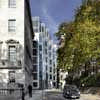
photo © Richard Bryant/Arcaid
280 High Holborn Development
Gabriela Hearst, corner of Brook Street and Davies Street, Mayfair
Architects: Foster + Partners
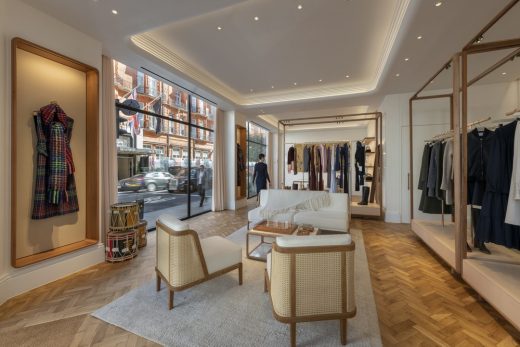
photography : Nigel Young / Foster + Partners
Gabriela Hearst London Store
Comments / photos for the Suburban Dreams: Architecture Foundation Films London page welcome
Websites : www.theaoc.co.uk / www.architecturefoundation.org.uk

